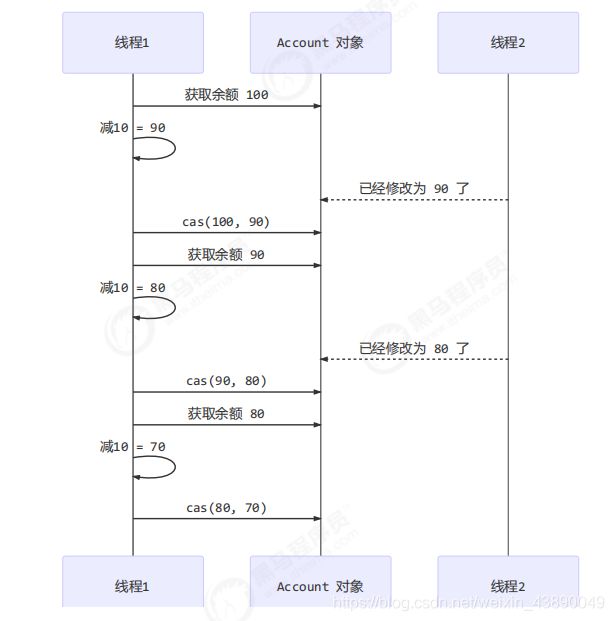共享模型之无锁(CAS和valotile)
共享模型之无锁-CAS
- 取款案例
- 解决方式
-
- 解决方式一
- 解决方式二
- 总结方式二---无锁CAS
- CPU核心数
取款案例
public class TestAccount {
public static void main(String[] args) {
//初始化余额为10000
Account account = new AccountUnsafe(10000);
//1000个线程同时运行
Account.demo(account);
}
}
class AccountUnsafe implements Account {
private Integer balance;
public AccountUnsafe(Integer balance) {
this.balance = balance;
}
@Override
public Integer getBalance() {
//synchronized (this) {
return this.balance;
//}
}
@Override
public void withdraw(Integer amount) {
//synchronized (this) {
this.balance -= amount;
//}
}
}
interface Account {
// 获取余额
Integer getBalance();
// 取款
void withdraw(Integer amount);
/**
* 方法内会启动 1000 个线程,每个线程做 -10 元 的操作
* 如果初始余额为 10000 那么正确的结果应当是 0
*/
static void demo(Account account) {
List<Thread> ts = new ArrayList<>();
for (int i = 0; i < 1000; i++) {
ts.add(new Thread(() -> {
account.withdraw(10);
}));
}
//定义开始时间
long start = System.nanoTime();
//1000个线程同时运行
ts.forEach(Thread::start);
ts.forEach(t -> {
try {
//必须使1000个线程同时运行完成,主线程main才能结束
t.join();
} catch (InterruptedException e) {
e.printStackTrace();
}
});
//定义结束时间
long end = System.nanoTime();
//输出余额和运行时间
System.out.println(account.getBalance()
+ " cost: " + (end-start)/1000_000 + " ms");
}
}
结果:
第一次:
2020 cost: 187 ms
第二次:
2370 cost: 193 ms
第三次:
4340 cost: 214 ms
每次运行结果都不同,说明多个线程并发运行对会对共享变量产生影响。多个线程交错访问使 account.withdraw 取款方法的线程不安全。
解决方式
解决方式一
加synChronized对象锁,先简单了解一下,下节介绍。
public class TestAccount {
public static void main(String[] args) {
//初始化余额为10000
Account account = new AccountUnsafe(10000);
//1000个线程同时运行
Account.demo(account);
}
}
class AccountUnsafe implements Account {
private Integer balance;
public AccountUnsafe(Integer balance) {
this.balance = balance;
}
@Override
public Integer getBalance() {
synchronized (this) {
return this.balance;
}
}
@Override
public void withdraw(Integer amount) {
synchronized (this) {
this.balance -= amount;
}
}
}
interface Account {
// 获取余额
Integer getBalance();
// 取款
void withdraw(Integer amount);
/**
* 方法内会启动 1000 个线程,每个线程做 -10 元 的操作
* 如果初始余额为 10000 那么正确的结果应当是 0
*/
static void demo(Account account) {
List<Thread> ts = new ArrayList<>();
for (int i = 0; i < 1000; i++) {
ts.add(new Thread(() -> {
account.withdraw(10);
}));
}
//定义开始时间
long start = System.nanoTime();
//1000个线程同时运行
ts.forEach(Thread::start);
ts.forEach(t -> {
try {
//必须使1000个线程同时运行完成,主线程main才能结束
t.join();
} catch (InterruptedException e) {
e.printStackTrace();
}
});
//定义结束时间
long end = System.nanoTime();
//输出余额和运行时间
System.out.println(account.getBalance()
+ " cost: " + (end-start)/1000_000 + " ms");
}
}
只需对余额balance的操作加上synChronized重量级锁。
解决方式二
使用CAS无锁方式
package com.lx;
import java.util.ArrayList;
import java.util.List;
import java.util.concurrent.atomic.AtomicInteger;
public class TestAccount {
public static void main(String[] args) {
Account account = new AccountCas(10000);
Account.demo(account);
}
}
//cas无锁方式实现
class AccountCas implements Account {
private AtomicInteger balance;
public AccountCas(int balance) {
this.balance = new AtomicInteger(balance);
}
@Override
public Integer getBalance() {
return balance.get();
}
@Override
public void withdraw(Integer amount) {
while(true) {
// 获取余额的最新值
int prev = balance.get();
// 要修改的余额
int next = prev - amount;
// 真正修改
if(balance.compareAndSet(prev, next)) {
break;
}
}
//balance.getAndAdd(-1 * amount);
}
}
interface Account {
// 获取余额
Integer getBalance();
// 取款
void withdraw(Integer amount);
/**
* 方法内会启动 1000 个线程,每个线程做 -10 元 的操作
* 如果初始余额为 10000 那么正确的结果应当是 0
*/
static void demo(Account account) {
List<Thread> ts = new ArrayList<>();
for (int i = 0; i < 1000; i++) {
ts.add(new Thread(() -> {
account.withdraw(10);
}));
}
//定义开始时间
long start = System.nanoTime();
//1000个线程同时运行
ts.forEach(Thread::start);
ts.forEach(t -> {
try {
//必须使1000个线程同时运行完成,主线程main才能结束
t.join();
} catch (InterruptedException e) {
e.printStackTrace();
}
});
//定义结束时间
long end = System.nanoTime();
//输出余额和运行时间
System.out.println(account.getBalance()
+ " cost: " + (end-start)/1000_000 + " ms");
}
}
结果:
0 cost: 205 ms
原理分析:
关键在于
private AtomicInteger balance;
public AccountCas(int balance) {
this.balance = new AtomicInteger(balance);
}
@Override
public void withdraw(Integer amount) {
while(true) {
// 获取余额的最新值
int prev = balance.get();
// 要修改的余额
int next = prev - amount;
// 真正修改
if(balance.compareAndSet(prev, next)) {
break;
}
}
//balance.getAndAdd(-1 * amount);
}
查看AtomicInteger 源码
public class AtomicInteger extends Number implements java.io.Serializable {
private volatile int value;
......
public AtomicInteger(int initialValue) {
value = initialValue;
}
public AtomicInteger() {
}
......
}
AtomicInteger 将余额balance封装进去,volatile 用来修饰value。volatile下节再主要介绍。
volatile能够保证程序的可见性和有序性,简单来讲,能购保证多个线程拿到的都是最新的数据。
其中的关键是 compareAndSet,它的简称就是 CAS (也有 Compare And Swap 的说法),它必须是原子操作。

如上图,线程1初始额度为100,做-10的操作,余额理应为90。在此期间线程2修改了初始额度为90,初始额度发生改变,则compareAndSet 会返回false,while(true)继续循环。初始额度变为90,做-10操作,再此期间线程2修改了初始额度为80,则compareAndSet 会返回false,while(true)继续循环。初始额度变为80,做-10操作,再此期间没有线程2的参与,则操作成功,break跳出循环。
总结方式二—无锁CAS
- 获取共享变量时,为了保证该变量的可见性,需要使用 volatile 修饰
- CAS 必须借助 volatile 才能读取到共享变量的最新值来实现【比较并交换】的效果
- 为什么无锁效率高?
无锁情况下,即使重试失败,线程始终在高速运行,没有停歇,而 synchronized 会让线程在没有获得锁的时候,发生上下文切换,进入阻塞。但无锁情况下,因为线程要保持运行,需要额外 CPU 的支持,,虽然不会进入阻塞,但如果没有分到时间片,仍然会进入可运行状态,还是会导致上下文切换。 - CAS 的特点
- CAS 是基于乐观锁的思想:最乐观的估计,不怕别的线程来修改共享变量,就算改了也没关系,我吃亏点再重试呗。
- synchronized 是基于悲观锁的思想:最悲观的估计,得防着其它线程来修改共享变量,我上了锁你们都别想改,我改完了解开锁,你们才有机会。
- CAS 体现的是无锁并发、无阻塞并发。
- 线程数少于CPU核心数时,使用CAS比较高效。
CPU核心数
CUP核数即一个CPU由多少个核心组成,核心数越多,代表这个CPU的运转速度越快,性能越好。对于同一个数据处理,一核CPU相当于1个人处理数据,双核CPU相当于2个人处理同一个数据,4核CPU相当于4个人去处理同一个数据,因此处理核心数越多,CPU的工作效率也就越高